- Growing Walnuts in the Garden: A Comprehensive Guide
- Introduction
- Choosing the Right Variety
- Site Selection
- Planting
- Care and Maintenance
- Pest and Disease Control
- Harvesting
- Conclusion
- Choosing the Right Walnut Species for Your Garden
- Climate Adaptability
- Tree Size
- Nut Yield and Quality
- Pest and Disease Resistance
- Pollination Requirements
- Growth Rate
- Overall Suitability
- Preparing the Soil for Walnut Trees
- 1. Soil Testing
- 2. Soil Amendments
- 3. Clearing the Area
- 4. Digging the Planting Hole
- 5. Fertilizer Application
- 6. Mulching
- 7. Watering
- Planting and Caring for Walnut Trees
- Choosing the Right Location
- Preparing the Soil
- Planting the Walnut Tree
- Watering and Fertilizing
- Pruning and Training
- Pest and Disease Control
- Harvesting Walnuts
- Conclusion
- Pruning and Training Walnut Trees
- 1. Start pruning at a young age
- 2. Remove competing branches
- 3. Thin out crowded branches
- 4. Prune for light penetration
- 5. Shape the tree canopy
- 6. Prune dead or damaged wood
- 7. Follow the “3 D’s” rule
- 8. Train the tree
- 9. Consider professional help
- Harvesting and Storing Walnuts
- Harvesting
- Storing
- Common Diseases and Pests Affecting Walnut Trees
- Diseases
- Pests
- Walnut Recipes and Culinary Uses
- 1. Walnut Oil Dressing
- 2. Walnut Bread
- 3. Candied Walnuts
- 4. Walnut Pesto
- Conclusion
- Question-answer:
- What are the different species of walnuts that can be grown in the garden?
- Are walnuts easy to grow in the garden?
- How long does it take for a walnut tree to produce nuts?
- Can walnuts be grown in containers?
- How do I care for a walnut tree in the garden?
- Can I grow walnuts from seeds?
- Video: Some Thoughts About Planting Under Black Walnut Trees // Garden Answer
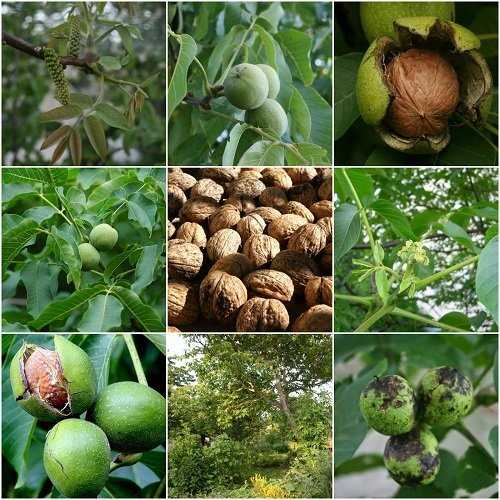
If you are a fan of nuts, you probably have heard of walnuts. Walnuts are not only delicious but also nutritious, making them a popular choice for many gardeners. Whether you have a large garden or a small balcony, you can grow your own walnut tree and enjoy the fresh harvest right from your backyard.
There are several species of walnuts, each with its unique characteristics. The most common species is the English walnut (Juglans regia), which is native to Persia. This species is known for its rich and buttery flavor, making it a favorite for eating fresh or in various recipes. Another popular species is the black walnut (Juglans nigra), which is native to North America. It has a bolder and earthier taste and is often used in baked goods and desserts.
Growing walnuts in your garden requires some patience and planning. Walnut trees are large and long-lived, so you need to ensure you have enough space and suitable growing conditions. They prefer deep, well-drained soil and full sun exposure. The trees can reach up to 60 feet in height, so make sure to plant them away from any structures or other plants that could be overshadowed.
Walnut trees are dioecious, meaning they have separate male and female flowers on different trees. To produce nuts, you need both a male and a female tree in close proximity. If you have limited space, consider planting a grafted tree that has both male and female flowers on the same tree. However, if you have enough room, it is recommended to plant a male tree and several female trees to ensure a good pollination and a higher yield.
If you decide to grow walnuts in your garden, be prepared to wait a few years before harvesting your first nuts. Walnut trees typically start producing nuts after four to six years, so patience is a virtue. However, once the trees start bearing fruits, you will be rewarded with a bountiful harvest of tasty and nutritious walnuts.
Whether you choose to grow English walnuts or black walnuts, having your own walnut tree in the garden can be a rewarding experience. Not only will you have a fresh supply of nuts, but you will also enjoy the beauty and shade that these majestic trees provide. So roll up your sleeves and start planting your walnut tree – you won’t regret it!
Growing Walnuts in the Garden: A Comprehensive Guide
Introduction
Walnuts are delicious and nutritious tree nuts that can be grown in home gardens. They can provide shade, beauty, and a bountiful harvest. This comprehensive guide will provide all the information you need to successfully grow walnuts in your garden.
Choosing the Right Variety
There are different species and varieties of walnuts that can be grown in gardens. Some common varieties include English walnut (Juglans regia), Black walnut (Juglans nigra), and Hybrid walnut (Juglans x intermedia). Consider the climate, soil conditions, and local regulations when selecting the right variety for your garden.
Site Selection
Walnut trees require a spacious and sunny location in the garden. They prefer well-drained soil with a pH level between 6 and 7. Ensure there is enough space for the tree’s mature size, as walnut trees can grow up to 60 feet tall and wide.
Planting
Before planting, prepare the soil by removing weeds and loosening it with a garden fork. Dig a hole that is wide and deep enough to accommodate the tree roots. Place the root ball in the hole and fill it back with soil, gently firming it around the roots. Water thoroughly after planting.
Care and Maintenance
Regular watering is essential during the tree’s first year. Provide an inch of water every week during dry spells. Mulch around the tree to retain moisture and control weeds. Fertilize the tree with a balanced fertilizer in early spring and mid-summer. Prune the tree in late winter to remove dead or damaged branches.
Pest and Disease Control
Walnut trees may be susceptible to pests and diseases such as walnut husk fly, walnut aphids, walnut blight, and walnut anthracnose. Regularly inspect the tree for signs of infestation or disease. Use organic or chemical controls as necessary to prevent or mitigate any issues.
Harvesting
Walnuts are ready for harvest when the outer husk turns brown and starts to split. Remove the husk and dry the nuts for a few weeks in a well-ventilated area. Crack the shells and enjoy the delicious nuts fresh or store them in an airtight container for later use.
Conclusion
Growing walnuts in the garden can be a rewarding experience. By choosing the right variety, providing proper care, and monitoring for pests and diseases, you can enjoy a bountiful harvest of fresh walnuts. Start growing your own walnut tree today and enjoy the many benefits it brings to your garden!
Choosing the Right Walnut Species for Your Garden
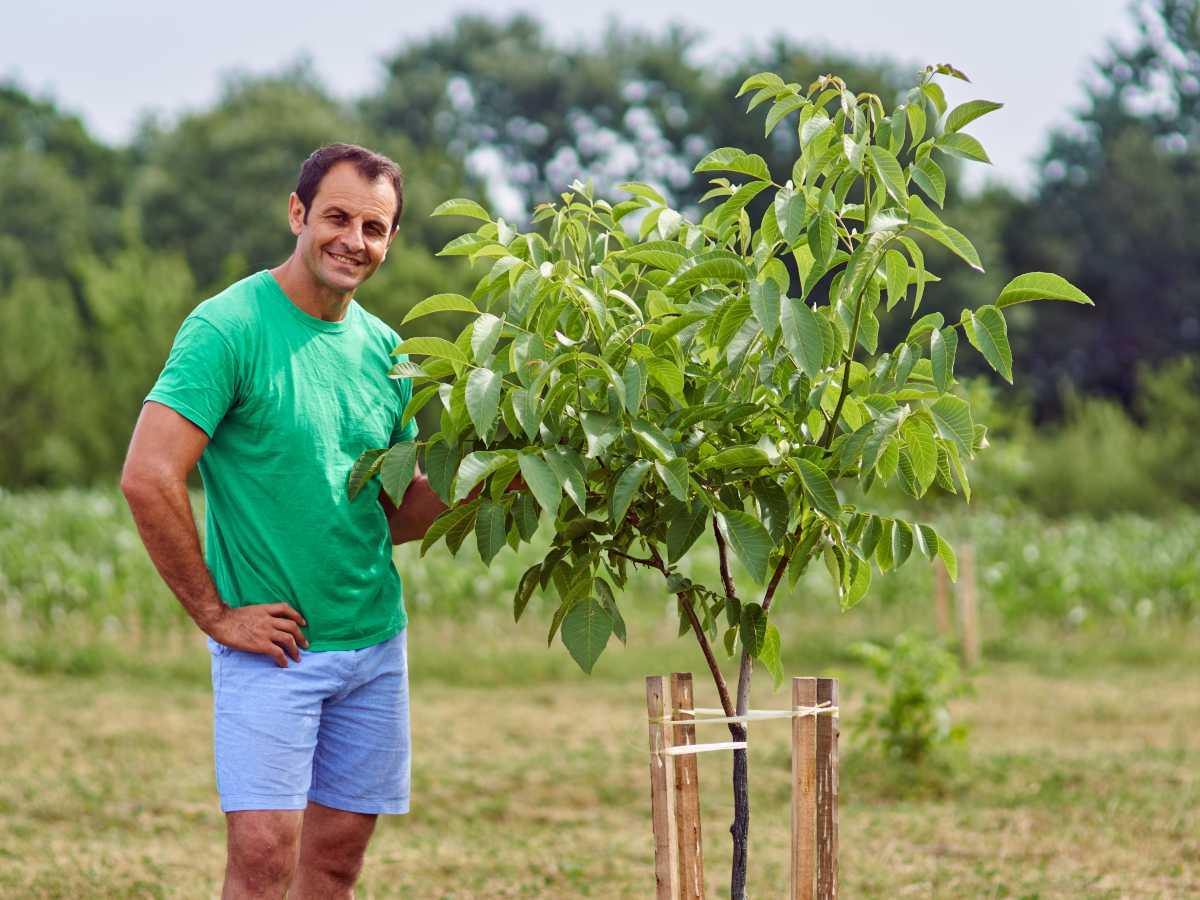

When it comes to growing walnuts in your garden, choosing the right species is crucial for success. Different walnut species have different characteristics and requirements, so it’s important to take these into consideration before making your selection. Here are some factors to consider when choosing the right walnut species for your garden:
Climate Adaptability
Walnut trees have different climate adaptabilities, so it’s important to choose a species that can thrive in your specific climate. Some species are more tolerant of colder temperatures, while others prefer warmer climates. Consider the average annual temperature, the number of frost-free days, and the chilling hours required by different walnut species before making your decision.
Tree Size
Walnut trees come in a variety of sizes, ranging from dwarf varieties that grow only a few feet tall to large trees that reach more than 100 feet in height. Consider the available space in your garden and choose a walnut species that fits well within that space. Remember to consider both the height and spread of the tree when making your decision.
Nut Yield and Quality
Different walnut species produce nuts of varying sizes, flavors, and quality. Consider what you are looking for in terms of nut yield and quality. Do you want a species that produces a high quantity of smaller nuts, or do you prefer a species that produces larger, sweeter nuts? Keep in mind that different species may also have varying harvesting times.
Pest and Disease Resistance
Some walnut species are more resistant to pests and diseases than others. Research the common pests and diseases that affect walnut trees in your area and choose a species that has a higher resistance to these issues. This will make it easier to maintain the health and productivity of your walnut trees in the long run.
Pollination Requirements
Walnut trees have different pollination requirements, with some species being self-fertile and others requiring cross-pollination with another compatible variety. Consider the pollination requirements of different walnut species and ensure that you have enough space and the right conditions to accommodate the necessary number of trees for successful pollination.
Growth Rate
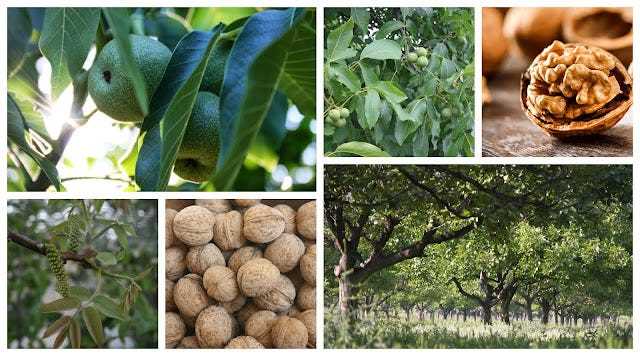

If you’re looking for quick results, consider the growth rate of different walnut species. Some species grow faster and reach maturity more quickly than others. Keep in mind that faster-growing species may require more maintenance and pruning to control their size and shape.
Overall Suitability
In the end, choose a walnut species that suits your overall preferences and goals for your garden. Consider factors such as tree appearance, fall color, and any other personal preferences that are important to you. Remember that growing walnuts is a long-term commitment, so make sure you choose a species that you will enjoy for years to come!
By taking these factors into consideration, you can choose the right walnut species for your garden and set yourself up for success in growing this delicious and nutritious nut. Happy walnut growing!
Preparing the Soil for Walnut Trees
Proper preparation of the soil plays a crucial role in the successful growth and development of walnut trees. Here are some essential steps to take when preparing the soil for planting walnut trees:
1. Soil Testing
Before planting walnut trees, it is important to conduct a soil test to determine the pH level and nutrient content of the soil. This information will help you make informed decisions regarding soil amendments and fertilizer application.
2. Soil Amendments
Once the soil test results are available, necessary soil amendments should be made. Walnut trees prefer well-draining soil with a pH range between 6 and 7. If the pH is too high or too low, the addition of lime or sulfur respectively may be necessary to adjust the pH level. Organic matter such as compost or well-rotted manure can also be incorporated to improve soil structure and fertility.
3. Clearing the Area
Before planting walnut trees, clear the area of any weeds, grass, or debris that may compete with the young trees for nutrients and water. Removing any existing vegetation will provide a clean slate for the walnut trees to establish themselves.
4. Digging the Planting Hole
The planting hole for walnut trees should be twice as wide and deep as the root ball. This will allow the roots to easily penetrate the soil and establish a strong foundation. It is essential to ensure that the hole is free from any compacted soil or rocks that may hinder root growth.
5. Fertilizer Application
Based on the soil test results, an appropriate fertilizer should be selected and applied according to the recommended rates. The fertilizer should be evenly distributed around the planting hole, keeping it away from direct contact with the roots.
6. Mulching
A layer of mulch around the base of the walnut tree can help conserve moisture, suppress weeds, and regulate soil temperature. Organic mulch such as wood chips or straw should be spread around the tree, avoiding direct contact with the trunk.
7. Watering
After planting, the walnut tree should be watered thoroughly to ensure that the roots are properly hydrated. Regular watering should be done, especially during dry periods, to promote healthy growth and establishment.
By following these steps, you can create an optimal environment for walnut trees to thrive and produce a bountiful harvest.
Planting and Caring for Walnut Trees
Choosing the Right Location
Walnut trees thrive in full sun and well-drained soil. Select a location with good air circulation to prevent diseases and pests. Ensure that there is sufficient space for the tree to grow, as walnut trees can reach a height of up to 100 feet.
Preparing the Soil
Before planting, prepare the soil by removing any weeds or grass from the area. Walnut trees prefer slightly acidic soil with a pH level between 6.0 and 7.5. Test the soil and amend it if necessary by adding organic matter.
Planting the Walnut Tree
Dig a hole that is deep and wide enough to accommodate the walnut tree’s root system. Gently place the tree in the hole, making sure that the bud union is slightly above the ground level. Backfill the hole with soil, firming it gently around the roots. Water thoroughly after planting.
Watering and Fertilizing
Water the newly planted walnut tree regularly, keeping the soil moist but not waterlogged. When watering, ensure that the root zone is adequately watered. Fertilize the tree in early spring and mid-summer with a balanced fertilizer to promote healthy growth.
Pruning and Training
Prune the walnut tree during its dormant season to remove dead or crossing branches. Also, shape the tree by pruning the central leader and maintaining an open canopy. Train the main branches to grow horizontally, as this will promote optimal nut production.
Pest and Disease Control
Monitor the walnut tree regularly for signs of pests or diseases, such as walnut husk flies or bacterial blight. Use natural or chemical pesticides when necessary to control infestations. Proper sanitation and removal of fallen leaves and fruit can also help reduce the risk of diseases.
Harvesting Walnuts
Walnuts are typically harvested in the fall when the outer husks split open. Collect the nuts from the ground and remove the husks. Leave the nuts to dry in a warm, well-ventilated area for several weeks before storing them in a cool, dry place.
Conclusion
By following these planting and care guidelines, you can successfully grow and maintain healthy walnut trees. With proper care and attention, your walnut tree will provide you with a bountiful harvest for years to come.
Pruning and Training Walnut Trees
Pruning plays a crucial role in the growth and development of walnut trees. Proper pruning techniques help promote a healthy tree structure, improve sunlight penetration, and enhance fruit production. Here are some important tips for pruning and training walnut trees:
1. Start pruning at a young age
It is recommended to start pruning walnut trees when they are young, ideally in their first year after planting. This allows you to shape the tree’s structure from the beginning and encourages proper branching patterns.
2. Remove competing branches
Walnut trees tend to have a central leader with lateral branches. It is important to identify any competing branches that may hinder the growth of the central leader. Remove these branches to maintain a dominant main trunk and prevent the tree from developing multiple leaders.
3. Thin out crowded branches
As walnut trees mature, it is common for branches to become crowded. Thinning out excessive branches helps improve air circulation and sunlight penetration, reducing the risk of diseases and improving fruit quality.
4. Prune for light penetration
Walnut trees require adequate sunlight for optimal growth and fruit production. Prune branches that obstruct sunlight penetration to ensure all parts of the tree receive sufficient light.
5. Shape the tree canopy
Prune branches to shape the tree’s canopy, encouraging an open and balanced structure. This allows for better light distribution and facilitates easier harvesting.
6. Prune dead or damaged wood
Regularly inspect your walnut trees for dead or damaged wood. Prune these branches as soon as possible to prevent the spread of diseases and maintain the overall health of the tree.
7. Follow the “3 D’s” rule
When pruning walnut trees, follow the “3 D’s” rule: remove branches that are dead, diseased, or damaged. This rule helps maintain the tree’s health and vitality.
8. Train the tree
During the early years of growth, train the walnut tree by pruning to encourage a strong and well-balanced framework. This involves removing lower branches and shaping the overall structure of the tree.
9. Consider professional help
If you are unsure about pruning techniques or have large and mature walnut trees, it may be wise to seek professional help. Arborists or experienced tree care specialists can provide guidance and ensure proper pruning practices.
By following these pruning and training tips, you can help your walnut trees thrive and maximize their fruit production. Remember to prune during the appropriate seasons and use clean pruning tools to prevent the spread of diseases.
Harvesting and Storing Walnuts
Harvesting
Harvesting walnuts is usually done in late summer or early fall, when the nuts are mature and fall naturally from the tree. There are a few signs that indicate the walnuts are ready for harvesting. The husk of the nut will have turned brown and cracked open, revealing the hard shell inside. You can also shake the tree gently to see if any ripe walnuts fall to the ground.
To harvest the walnuts, gather them from the ground and remove any remaining husks. Use gloves during this process, as the husks can stain hands and clothing. It is important to handle the walnuts gently to avoid damaging them. If the nuts are not fully mature or have a soft shell, they may not be suitable for storage or consumption.
Storing
After harvesting, it is important to properly store the walnuts to maintain their freshness and flavor. Here are some tips for storing walnuts:
- Remove any remaining debris or husks from the nuts.
- Spread the walnuts in a single layer on a tray or mesh screen to allow for air circulation.
- Store the walnuts in a cool, dry place with good ventilation.
- Avoid storing walnuts near strong-smelling foods, as they can absorb odors.
- Check regularly for any signs of mold or spoilage, and discard any affected walnuts.
If stored properly, walnuts can stay fresh for several months. To extend their shelf life, you can also store walnuts in the refrigerator or freezer. Just make sure to place them in an airtight container or freezer bag to prevent moisture and freezer burn.
Common Diseases and Pests Affecting Walnut Trees
Diseases
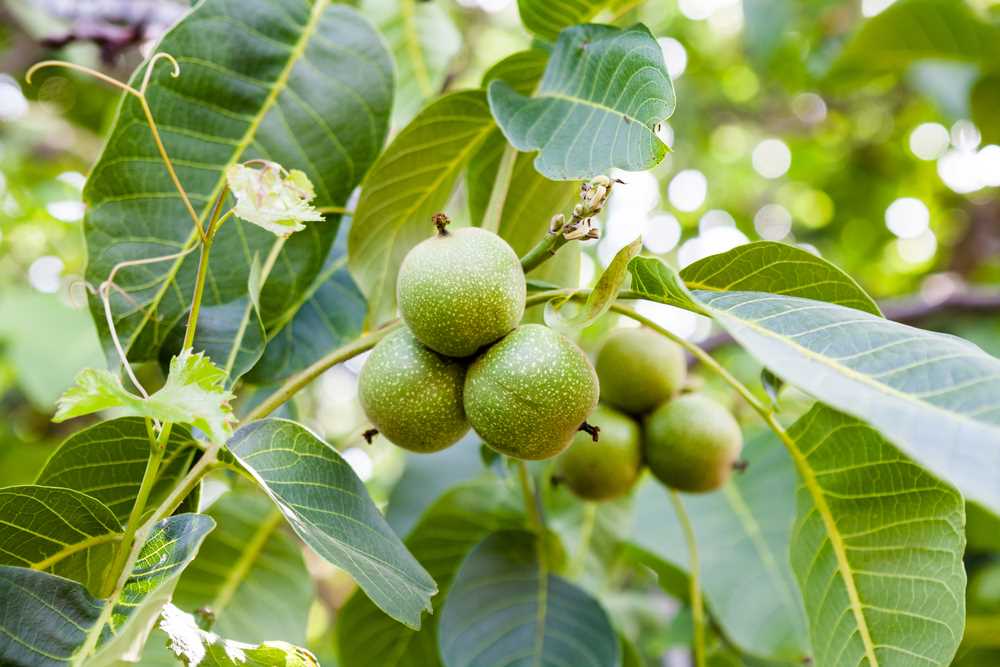

- Crown Gall: This is a bacterial disease that causes tumors or galls to form on the walnut tree’s roots and crown. It can lead to reduced growth and productivity of the tree.
- Walnut Blight: Caused by a bacterium, this disease attacks the leaves, twigs, and nuts of the walnut tree. It causes dark lesions on the leaves and can result in reduced nut quality and yield.
- Thousand Cankers Disease: This disease is caused by a fungus and carried by the walnut twig beetle. It results in the formation of small cankers on branches and trunk, eventually leading to dieback and death of the tree.
- Verticillium Wilt: A fungal disease, it affects the vascular system of the walnut tree, causing wilting, yellowing of leaves, and eventual decline. It can lead to tree death if left untreated.
Pests
- Codling Moth: This insect pest mainly affects the walnut tree’s nuts. The larvae bore into the nuts and cause damage, leading to reduced quality and yield.
- Aphids: These tiny insects can infest walnut trees, sucking sap from the leaves and causing them to curl and distort. They can also transmit certain diseases.
- Walnut Husk Fly: This fly lays its eggs on the husks of developing walnuts. The hatching larvae feed on the husks, leading to early nut drop and reduced yield.
- Walnut Caterpillar: The larvae of this caterpillar feed on walnut foliage, causing defoliation and potentially impacting the overall health of the tree.
It is important to monitor walnut trees regularly for signs of diseases and pests. Early detection and appropriate management practices can help prevent and control the spread of these issues, ensuring the health and productivity of the walnut trees.
Walnut Recipes and Culinary Uses
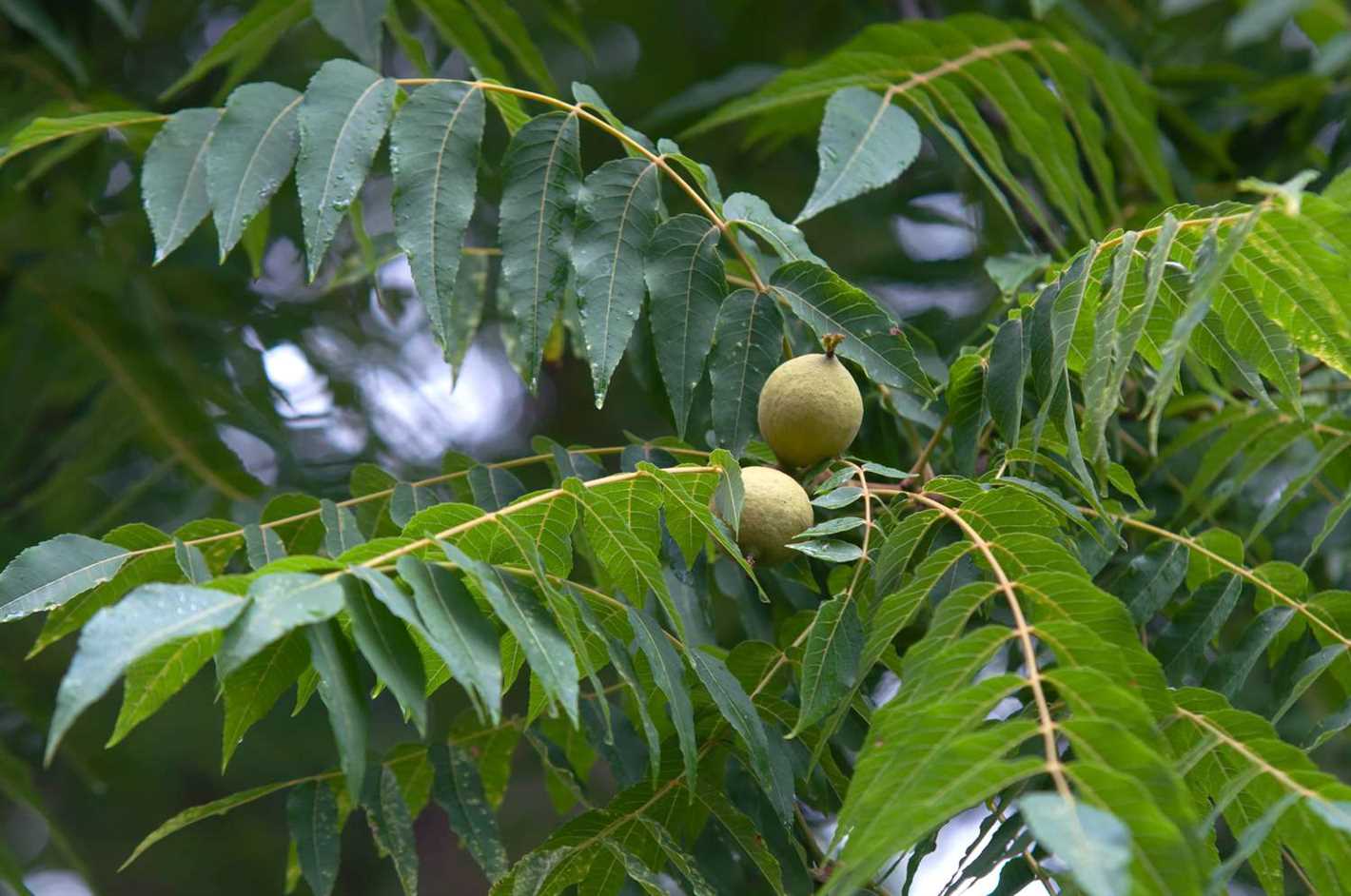

1. Walnut Oil Dressing
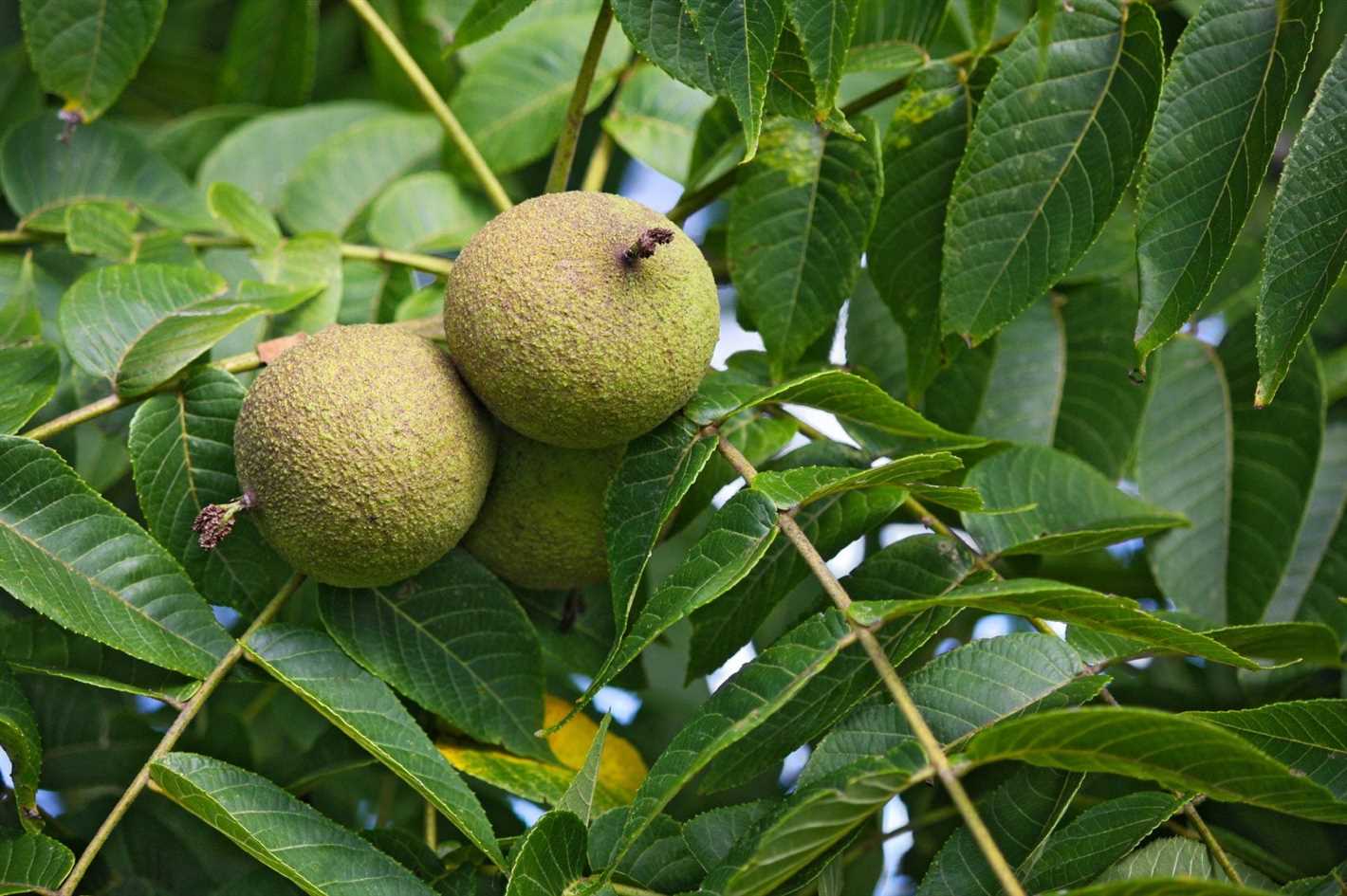

Walnut oil, with its rich and nutty flavor, makes a delicious salad dressing. Here’s a simple recipe to try:
- Ingredients:
- 2 tablespoons walnut oil
- 1 tablespoon lemon juice
- 1 teaspoon Dijon mustard
- Salt and pepper to taste
- Instructions:
- In a small bowl, whisk together the walnut oil, lemon juice, Dijon mustard, salt, and pepper.
- Drizzle the dressing over your favorite salad and toss to evenly coat.
- Enjoy the delicious nutty flavor of the walnut oil dressing!
2. Walnut Bread
Walnuts add a delightful crunch and flavor to homemade bread. Here’s a recipe to make your own walnut bread:
- Ingredients:
- 2 cups all-purpose flour
- 1 cup chopped walnuts
- 1 tablespoon sugar
- 1 teaspoon salt
- 2 teaspoons active dry yeast
- 1 cup warm water
- Instructions:
- In a large mixing bowl, combine the flour, chopped walnuts, sugar, and salt.
- In a separate small bowl, dissolve the yeast in warm water and let it sit for 5 minutes until it becomes frothy.
- Add the yeast mixture to the dry ingredients and mix until a dough forms.
- Knead the dough on a lightly floured surface for about 5 minutes until it becomes smooth and elastic.
- Place the dough in a greased bowl, cover it with a clean cloth, and let it rise in a warm place for about 1 hour or until it doubles in size.
- Punch down the dough, shape it into a loaf, and place it in a greased loaf pan.
- Cover the loaf with the cloth again and let it rise for another 30 minutes.
- Bake the bread in a preheated oven at 350°F (175°C) for 30-35 minutes or until golden brown.
- Remove the bread from the pan and let it cool on a wire rack before slicing.
- Enjoy the aroma and taste of freshly baked walnut bread!
3. Candied Walnuts
Candied walnuts are a sweet treat that can be enjoyed on their own or used as a topping for desserts or salads. Here’s how to make them:
- Ingredients:
- 1 cup walnut halves
- 1/4 cup granulated sugar
- 1 tablespoon butter
- Pinch of salt
- Instructions:
- In a medium-sized skillet, melt the butter over medium heat.
- Add the walnuts, granulated sugar, and salt to the skillet.
- Stir constantly until the sugar melts and coats the walnuts evenly.
- Reduce the heat to low and continue stirring until the walnuts are caramelized and golden brown.
- Transfer the candied walnuts onto a parchment-lined baking sheet and let them cool completely.
- Once cooled, break them into smaller pieces if desired.
- Use them as a topping for desserts like ice cream or salads for an extra crunch and sweetness.
4. Walnut Pesto
Traditional pesto gets a delicious twist with the addition of walnuts. Here’s how to make walnut pesto:
- Ingredients:
- 2 cups fresh basil leaves
- 1/2 cup walnuts
- 1/2 cup grated Parmesan cheese
- 2 garlic cloves, minced
- 1/2 cup olive oil
- Salt and pepper to taste
- Instructions:
- In a food processor, combine the basil leaves, walnuts, Parmesan cheese, and minced garlic cloves. Pulse until they are finely chopped.
- Slowly add the olive oil while continuing to pulse, until the mixture forms a smooth paste.
- Season with salt and pepper to taste.
- Use walnut pesto as a sauce for pasta, a spread for sandwiches, or a dip for vegetables.
Conclusion
Walnuts are versatile nuts that can be used in a variety of culinary creations. Whether you’re making a salad dressing, baking bread, creating a sweet treat, or preparing a delicious sauce, walnuts add a unique flavor and texture to your dishes. Explore these recipes and let the rich taste of walnuts enhance your cooking.
Question-answer:
What are the different species of walnuts that can be grown in the garden?
There are several species of walnuts that can be grown in the garden, including the Persian walnut (Juglans regia), the black walnut (Juglans nigra), and the California walnut (Juglans californica).
Are walnuts easy to grow in the garden?
Walnuts can be somewhat challenging to grow in the garden, as they have specific soil and climate requirements. They prefer deep, well-drained soil and a temperate climate. However, with the right conditions, they can be a rewarding and nutritious addition to the garden.
How long does it take for a walnut tree to produce nuts?
It usually takes about 4-7 years for a walnut tree to start producing nuts. However, the exact time can vary depending on the species, growing conditions, and maintenance practices. Patience is key when growing walnuts!
Can walnuts be grown in containers?
While it is possible to grow walnuts in containers, it is not ideal. Walnut trees have deep and extensive root systems, which makes them difficult to grow in small containers. It is best to plant them directly in the ground where they have ample space to spread their roots.
How do I care for a walnut tree in the garden?
Caring for a walnut tree in the garden involves providing it with well-drained soil, regular watering, and protection from pests and diseases. Pruning the tree to remove dead or damaged branches can also help promote healthy growth and improve fruit production.
Can I grow walnuts from seeds?
Yes, you can grow walnuts from seeds. However, keep in mind that it may take several years for the tree to start producing nuts, and the resulting tree may not have the same characteristics as the parent tree. It is generally recommended to purchase grafted walnut trees from nurseries for more predictable and quicker results.







